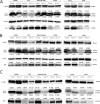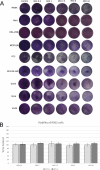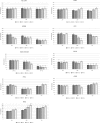Caprine herpesvirus 1 (CpHV-1) as a potential candidate for oncolytic virotherapy
- PMID: 30409104
- PMCID: PMC6343687
- DOI: 10.1080/15384047.2018.1504722
Caprine herpesvirus 1 (CpHV-1) as a potential candidate for oncolytic virotherapy
Abstract
Caprine Herpesvirus type 1 (CpHV-1) is a species-specific herpes virus able to induce apoptosis in several biological systems. In the present study we aimed to investigate the ability of CpHV-1 to reduce cells viability, to replicate and to cause cell death also in human cancer cell lines. We tested the CpHV-1 effects on HEL-299, Vero, MDA-MB-468, HeLa, U2OS, PC3, A549 and K562 neoplastic cell lines and on MDBK cells. Firstly, we evaluated the effect of CpHV-1 infection on cell viability by MTT assay and our data showed that CpHV-1 can induce a marked cytopathic effect (CPE) in most of cell lines tested, except for HEL-299, Vero and K562 cells. The reduction of cell viability was associated with a significant increase of viral production. We next investigated if CpHV-1 was able to induce cell death and so through western blotting analysis we evaluated cleaved caspase 3, LC3II and p62 protein levels after infection. Caspase 3 activation was detected in MDBK cells and, even if at different times p.i., also in MDA-MB-468, U2OS, and PC3 cell lines, while LC3II increase and concomitant p62 protein reduction were observed only in U2OS, and A549 cells, no significant alteration of these proteins was observed in the other cell lines tested. Finally, to confirm virus ability to trigger apoptosis we performed an Annexin-V apoptosis test after 24 h p.i. Although we need to further explore mechanisms underlying CpHV-1 treatment, this study could serve as the basis for the development of new treatment options aiming to fight several cancer types.
Keywords: Oncolytic virotherapy; apoptosis; autophagy; human cancer cells.
Figures





Similar articles
-
The Oncolytic Caprine Herpesvirus 1 (CpHV-1) Induces Apoptosis and Synergizes with Cisplatin in Mesothelioma Cell Lines: A New Potential Virotherapy Approach.Viruses. 2021 Dec 8;13(12):2458. doi: 10.3390/v13122458. Viruses. 2021. PMID: 34960727 Free PMC article.
-
Modulation of apoptosis by caprine herpesvirus 1 infection in a neuronal cell line.J Cell Biochem. 2013 Dec;114(12):2809-22. doi: 10.1002/jcb.24628. J Cell Biochem. 2013. PMID: 23836554
-
Antigenic relationships between Caprine alphaherpesvirus 1 (CpHV-1) and Bovine alphaherpesvirus 1 (BoHV-1) and experimental CpHV-1 infection of kids and calves.Microb Pathog. 2019 Nov;136:103663. doi: 10.1016/j.micpath.2019.103663. Epub 2019 Aug 9. Microb Pathog. 2019. PMID: 31404631
-
Evolution of oncolytic viruses: novel strategies for cancer treatment.Immunotherapy. 2013 Nov;5(11):1191-206. doi: 10.2217/imt.13.123. Immunotherapy. 2013. PMID: 24188674 Review.
-
Oncolytic Immunotherapy.Surg Oncol Clin N Am. 2019 Jul;28(3):419-430. doi: 10.1016/j.soc.2019.02.007. Epub 2019 Apr 5. Surg Oncol Clin N Am. 2019. PMID: 31079797 Review.
Cited by
-
Transcriptomic insights into pseudorabies virus suppressed cell death pathways in neuroblastoma cells.Front Microbiol. 2024 Sep 19;15:1430396. doi: 10.3389/fmicb.2024.1430396. eCollection 2024. Front Microbiol. 2024. PMID: 39364165 Free PMC article.
-
The Microalga Skeletonema marinoi Induces Apoptosis and DNA Damage in K562 Cell Line by Modulating NADPH Oxidase.Molecules. 2022 Nov 27;27(23):8270. doi: 10.3390/molecules27238270. Molecules. 2022. PMID: 36500363 Free PMC article.
-
Modifications of the PI3K/Akt/mTOR axis during FeHV-1 infection in permissive cells.Front Vet Sci. 2023 Mar 21;10:1157350. doi: 10.3389/fvets.2023.1157350. eCollection 2023. Front Vet Sci. 2023. PMID: 37026095 Free PMC article.
-
Apoptosis is mediated by FeHV-1 through the intrinsic pathway and interacts with the autophagic process.Virol J. 2023 Dec 12;20(1):295. doi: 10.1186/s12985-023-02267-w. Virol J. 2023. PMID: 38087282 Free PMC article.
-
Antiviral Activity of Nitazoxanide and Miltefosine Against FeHV-1 In Vitro.Vet Med Int. 2024 Oct 19;2024:8849561. doi: 10.1155/2024/8849561. eCollection 2024. Vet Med Int. 2024. PMID: 39464309 Free PMC article.
References
Publication types
MeSH terms
LinkOut - more resources
Full Text Sources
Research Materials
Miscellaneous
